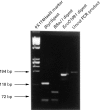Diagnosis of Fusarium keratitis in an animal model using the polymerase chain reaction
- PMID: 9602631
- PMCID: PMC1722506
- DOI: 10.1136/bjo.82.3.306
Diagnosis of Fusarium keratitis in an animal model using the polymerase chain reaction
Abstract
Aims/background: The purpose of this study was apply the polymerase chain reaction (PCR) to develop a sensitive, specific, and rapid test to diagnose Fusarium keratitis. Fusarium is the most common cause of fungal corneal infection in some parts of the world. It is often difficult to establish that a keratitis is due to fungal infection.
Methods: Fusarium solani keratitis was induced in three eyes of three rabbits by injection of a suspension of the fungus into the anterior corneal stroma. In one rabbit the contralateral eye served as a control. From four to 28 days after inoculation, the corneas were scraped for culture, then scraped and swabbed for PCR analysis. The PCR was performed with primers directed against a portion of the Fusarium cutinase gene, and the presence or absence of this amplified target sequence was determined by agarose gel.
Results: The amplified DNA sequence was detected in 25 of 28 samples from the corneas infected with Fusarium, for a sensitivity of 89%. Only three of the 14 samples from these eyes with Fusarium keratitis were positive by culture, for a sensitivity of 21%. Seven of eight control samples were negative by the PCR based test, for a specificity of 88%.
Conclusion: This PCR based test holds promise of being an effective method of diagnosing Fusarium keratitis as well as Fusarium infections at other sites.
Figures






References
Publication types
MeSH terms
LinkOut - more resources
Full Text Sources
Other Literature Sources
